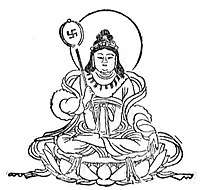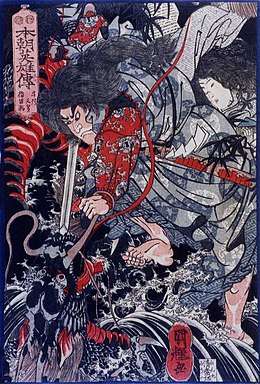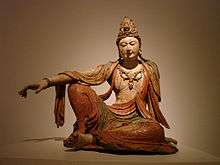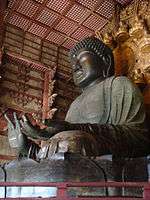Marici (Buddhism)
Mārīcī (Sanskrit: मारीची, lit. "Ray of Light"), is a deva, as well as a bodhisattva associated with light and the Sun. She is among the lists one of the guardian devas, specifically the Sixteen Devas (十六諸天), the Twenty Devas (二十諸天) and the Twenty-Four Devas (二十四諸天). In Taoism and Chinese folk religion, Doumu (Chinese: 斗母元君; pinyin: Dǒumǔ Yuánjūn) is considered to be synonymous with Mārīcī within Chinese Esoteric Buddhism.
| Mārīcī | |
|---|---|
 | |
| Sanskrit | मारीची
Mārīcī |
| Chinese | 摩利支天
(Pinyin: Mólìzhī Tiān) |
| Japanese | (romaji: Marishiten) |
| Korean | 마리지천
(RR: Mariji Cheon) |
| Thai | มารีจี |
| Tibetan | འོད་ཟེར་ཅན་མ་ Wylie: 'od zer can ma THL: Özerchenma |
| Vietnamese | Ma Lợi Chi Thiên |
| Information | |
| Venerated by | Mahāyāna, Vajrayāna
|
Iconography
Mārīcī is depicted in several ways. Some examples included:
- As a man or woman on an open lotus, the lotus itself sometimes perched on the back of seven sows.
- As a male deity riding a boar, often having two or six arms.
- Riding a fiery chariot pulled by seven savage boars or sows.
- As a multi-armed woman with a different weapon in each hand standing or sitting on the back of a boar.
- As having three faces and six or eight arms.
In Tibetan literature, the Bari Gyatsa contains five different descriptions of Mārīcī:
- Oḍḍiyāna Mārīcī
- Kalpa Ukta Mārīcī
- Kalpa Ukta Vidhinā Sita Mārīcī
- Aśokakāntā Mārīcī
- Oḍḍiyāna Krama Mārīcī
The Drub Tab Gyatso has six descriptions:
- White with five faces and ten hands
- Yellow with three faces and eight hands
- Yellow with three faces and eight hands
- Dharmadhātu Īśvarī, red with six faces and twelve hands
- Picumī, yellow with three faces and eight hands
- Red with three faces and twelve hands
The Nartang Gyatsa and Rinjung of Taranata describe one form.
Both the Vajravali and Mitra Gyatsa describe a mandala of Mārīcī that includes twenty-five surrounding figures.[1]
This is not an exhaustive list, and many more depictions of Mārīcī exist throughout the Buddhist world.
Origins
The origins of Mārīcī are obscure; however, she appears to be an amalgamation of Indic, Iranian and non-Indo-Iranian[2] antecedents spanning 1500 years.
She is also thought to have originated from the Vedic goddess of dawn Uṣas.[3]
Region
Tibet

Three texts are preserved in the Kriya Tantra of the Tibetan Kangyur in which Mārīcī is the primary subject:
- The Incantation of Mārīcī (Skt. ārya mārīcī nāma dhāraṇī, Wyl. 'phags ma 'od zer can zhes bya ba'i gzungs, D 564)
- The Sovereign Practices Extracted from the Tantra of Māyāmārīcī (Skt. Māyāmārīcījāta tantrād uddhitaṃ kalparājā, Wyl. sgyu ma'i 'od zer can 'byung ba'i rgyud las phyung ba'i rtog pa'i rgyal po’’, D 565)
- The Seven Hundred Practices of Mārīcī from the Tantras (Skt. ārya mārīcī maṇḍalavidhi mārīcījāta dvādaśasahasra uddhitaṃ kalpa hṛdaya saptaśata, Wyl. ‘phags ma 'od zer can gyi dkyil 'khor gyi cho ga 'od zer can 'byung ba'i rgyud stong phrag bcu gnyis pa las phyung ba'i rtog pa'i snying po bdun brgya pa’’, D 566)
Several more texts may be found in the Dergé Tengyur commentaries.
China

In China, Mārīcī is worshiped as both a Buddhist and Taoist deity. She is highly revered in Esoteric Buddhism. Most often, she is depicted with three eyes in each of her three faces; with four arms on each side of her body. Two of her hands are held together, and the other six hold a sun, moon, bell, golden seal, bow, and halberd. She is either standing/sitting on top of a lotus or pig, or on a Lotus on top of seven pigs. She is celebrated on the 9th day of the 9th lunar month.
Due to similar iconography, she is often confused with the Bodhisattva Cundī. Among Chinese Buddhists, she is worshiped as the goddess of light and as the guardian of all nations, whom she protects from the fury of war. [5]
In Taoism, Doumu remains a popular deity and is often referred to as the Queen of Heaven (Chinese: 天后; pinyin: Tiān Hòu) and is widely worshiped as the Goddess of Beidou (the Chinese equivalent of Ursa Major except that it also includes 2 "attendant" stars). She is also revered as the mother of the Nine Emperor Gods who are represented by the nine stars in the Beidou constellation.[6] Legend has it that one spring day, a queen went to bathe in a pond. Upon entering she suddenly felt "moved" and nine lotus buds rose from the pond. Each of these lotus buds opened to reveal a star which then became the Beidou constellation.
She is worshiped today in Taoist temples like the White Cloud Temple and the Tou Mu Kung Temple which has both Taoist and Buddhist influences.
Doumu is chronicled in three canonical Daozang texts, from which the above stories have been extracted. These three texts were compiled during the Song Yuan, according to the each entry’s preface in the Zhengtong daozang (Numbered according to Schipper, 1975). They are Dz 45: 'Yùqīng Wúshàng Língbǎo Zìrán Běidǒu Běnshēng Jīng' 玉清無上靈寶自然北斗本生經, True and Unsurpassed Lingbao Scripture from the Yuqing Heaven on the Spontaneous Origin of the Northern Dipper; Dz 621: Tàishàng Xuánlíng Dǒumǔ Dàshèng Yuánjūn Běnmìng Yánshēng Xīnjīng 太上玄靈斗姆大聖元君本命延生心經, Heart Scripture of Original Destiny and Extending Life of the Great Sagely Goddess Dipper Mother; and Dz 1452: Xiāntiān Dǒumǔ Qíngào Xuánkē 先天斗姆秦告玄科, Mysterious Rite for Petitioning the Dipper Mother of Former Heavens.
Japan
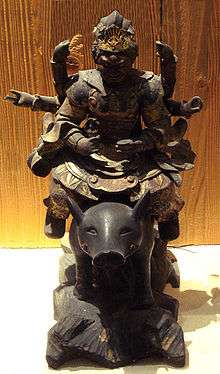
Mārīcī is an important deity in the Shingon and Tendai schools, and was adopted by the Bujin or Samurai in the 8th century CE as a protector and patron.
While devotions to Mārīcī predate Zen Buddhism, they appear to employ a similar meditative model to enable the warrior to achieve a heightened state of mind. They lost interest in the issues of victory or defeat (or life and death), thereby transcending conventional understandings of mortality. The end result was that they became a better warrior.
Devotion to Mārīcī was to expected to provide a way to achieve selflessness and compassion through mastery of the self. Some martial arts schools also worshiped Mārīcī as a guardian deity of their lineage. The school of Tenshin Shōden Katori Shintō-ryū is an example of this, whose blood pledge chart (Keppan) ordered the disciples to submit to Futsunushi-no-Mikoto and accept Mārīcī's punishment if they commit sins against the school's rule. This is understood as being "the God of Katori's holy commandment."
The most outstanding example is the worship of Mārīcī by the Yagyū Shinkage-ryū. In the aftermath of the battle of Sekigahara, Tokugawa Ieyasu made a vow to protect this style as well as the Yagyū family in exchange for their teachings. Because of this, Shinkage style has been permeated with esoteric Buddhist teachings such as the practice of mantra and mudra, which are said to confer invisibility upon a warrior.
At the age of 12 or 13, Yagyū Renya wrote the Shinkage Ryū Heihō Mokuroku Renya Kudensho (新陰流兵法目録柳生連也口伝書 Scroll of Renya's oral teachings about the Art of War according to the style of the New-Shadow), a treasured scroll discussing the theory and technique of the first and second Sōke compared to those of his father, the Yagyū Shinkage-ryū 3rd Sōke, Yagyū Toshitoshi. Martial arts were changing because samurai no longer fought wearing a complete set of armor, but instead wearing civilian clothing. The headmaster made the choice to adapt to the current time. Sekishūsai also created the Mutō-dori techniques, which were absent from the original Shinkage-ryū of headmaster Kamiizumi, which he demonstrated on Shōgun Tokugawa Ieyasu.
Unlike many other high ranked samurai of the Edo period, Renya fully mastered the core principles of Shinkage-ryū and Marobashi which resulted in a great deal of fame. One evening, Renya was attacked, though he was able to kill his assailant in a single blow with his wakizashi. The wakizashi forged by Hata Mitsuyo was nicknamed "Oni-hōchō" (the demon's kitchen knife), and many copies of various quality were made by swordsmiths of the time, with its peculiar kata-shinogi-zukuri (片鎬造) shape. Yagyū Renya was said to possess Marobashi, which included a deep understanding of combat and warrior instinct. His book was never shown to anyone, and he wrote on the cover that someone foolish enough to break the seal would be blinded by Mārīcī. According to Renya's strong beliefs, the Kudensho was passed down only to Shinkage-ryū headmasters.
Samurai would invoke Mārīcī at sunrise to achieve victory. Since Mārīcī means "light" or mirage, she was invoked to escape the notice of one's enemies.
Mārīcī was also later worshiped in the Edo period as a goddess of wealth and prosperity by the merchant class, alongside Daikokuten (大黒天) and Benzaiten (弁財天) as part of a trio of "three deities" (三天 santen).
See also
- List of solar deities
- Lunar deity
- Marichi Thakurani
References
- "Buddhist Deity: Marichi". Himalayan Art Resources. Retrieved 2019-03-02.
- Hall, David Avalon (1990). Marishiten: Buddhism and the warrior Goddess, Ph.D. dissertation, (Ann Arbor: University microfilms), p. 45.
- "摩利支天". Butuzou World 仏像ワールド. Retrieved 2019-04-21.
- Kaufman, Asha (2013-03-19). "Treasury of Lives: The Tenth Karmapa, Choying Dorje". Tricycle. Retrieved 2017-09-03.
- Keith Stevens (1997). Chinese Gods: The Unseen World of Spirits and Demons. Colins and Brown. p. 94. ISBN 1-85028-409-1.
- Keith Stevens (1997). Chinese Gods: The Unseen World of Spirits and Demons. Colins and Brown. p. 105. ISBN 1-85028-409-1.
Further reading
- Hall, David Avalon. (2013). The Buddhist Goddess MARISHITEN: A Study of the Evolution and Impact of Her Cult on the Japanese Warrior. Global International. ISBN 978-90-04-25010-9
- Hall, David Avalon. (1997). "Marishiten: Buddhist Influences on Combative Behavior" in Koryu Bujutsu: Classical Warrior Traditions of Japan. Koryu Books, pp. 87–119. ISBN 1-890536-04-0
- Mol, Serge (2008). Invisible armor: An Introduction to the Esoteric Dimension of Japan’s Classical Warrior Arts. Eibusha. pp. 1–160. ISBN 978-90-8133610-9.
